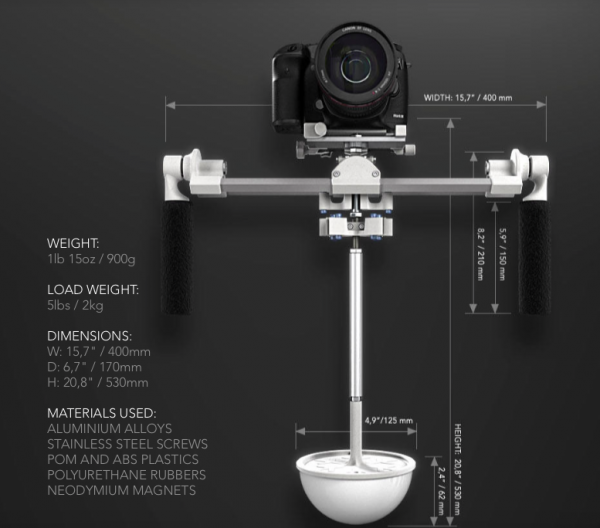
Ever since Freefly introduced the Movi back in 2013, there has been a endless stream of 3-axis stabilised gimbals flooding the market. Mechanical hand-held gimbals such as the Glidecam and Steadicam Solo have taken a back seat to their new electronic counterparts.
A new company called SNOW has bucked the trend and come up with a purely mechanical gimbal designed for cameras weighing up to 5lbs (2kg). What is unique about the SNOW is that it features a twin-grip system that has been designed to make it easier to use for longer periods of time without cramping your arms. Mechanical stabilisers have traditionally employed a single handle design and this can make them difficult to use for prolonged periods without using an additional arm and vest. The only downside I can see with going with a twin-grip system is that the gimbals footprint becomes significantly wider and won’t be able to go in places where a single handle gimbal can.
To balance the twin-grip design the SNOW uses a counterweight that is a small tank filled with water. According to SNOW, this helps eliminate the ‘pendulum effect’ you can get when shooting with other counterweighted gimbals. As the swinging tank moves the flowing fluid changes the center of gravity and forces the rig to stay vertical. Just how well this concept actually works is yet to be proven. The main problem I can see is if you were to use this in a place where water wasn’t readily available, or in temperatures where the water may actually freeze inside the tank. SNOW recommend replacing the water with anti-freeze if your using it in extremely cold environments.
All common DSLR, bridge and video cameras that are under the specified weight can be attached to the included plate and fixed in with a standard screw. To balance your camera you position the plate precisely at the X and Y axes. The Z balance depends on the vertical position of the balancer tank. According to SNOW balancing can be done in under a minute, which seems like a very bold claim indeed. I don’t know of a single gimbal mechanical or electronic that can be balanced in under a minute.
You can operate the SNOW pan via the automated follow mode. The camera slowly follows the rig’s direction using clever built-in magnetic dampers. The Tilt axis can be changed with your fingertips. As you hold the grips you can tilt the rig up or down. The Roll axis is always vertical when shaking the grips, but you can be slightly changed by twisting the rig.
SNOW claims the big benefit over using an electronic gimbal is that it does not require any special maintenance. The gimbal uses no electronics, no cables and no batteries. The rig is waterproof, shock resistant and heat resistant. The SNOW also only weighs 1lb 15oz (900g) which gives it a significant weight advantage over most electronic gimbals with a similar payload capacity. It is however heavier than both the Steadicam Merlin 2 and some of the Glidecam offerings.
According to the company, SNOW has been precision engineered to be a ultra-lightweight camera stabilizer rig. The frame is made of aluminum tubes, the axes and screws are stainless steel. Metal parts are composited with industrial plastics and rubbers which are 3D-printed and moulded. Just how durable it will be out in the field over a prolonged period of time is something that only time will tell.
It is always good to see a new company try and come up with something that is a little bit different to other offerings on the market. The concept is interesting and the vision on their website looks fairly good. Just how well it works in reality could be another story entirely. There is already so much competition in the mechanical and electronic gimbal market that SNOW may well have a tough time trying to convince people to go with a yet to be proven system.
The SNOW is currently available as a pre-order on Indiegogo for $499US. For more information head over to the SNOW website.






